updated 12-01-2014
What Ever Happened to Tom Ogle?
His super carburetor gave 100 mpg on a 427 inch v8 1970 Ford Galaxy
By Ron Laytner; Edit International; Copyright 2010
Did the world not go green because of a murder? Maybe 2 murders?

The world is telling us to Go Green; from Sesame Street to the Campaign Trail, and Going Green has become as much a marketing tool as a call for action. But what most American’s don’t know is that these problems were solved thirty years ago by the brilliant invention of a Texas high school dropout.
In 1978 I first interviewed Tom Ogle who created a device replacing the carburetor and allowed his 4,000 pound car to get 100 miles per gallon. He should have gone on to change history and become one of the world’s richest men. He was young, confident and feared nothing. But he was wrong – dead wrong. Four years later Tom, at age 24, was in his grave and his invention, buried.
***
I stood outside the Smuggler’s Inn, a restaurant in El Paso, where I’d just interviewed Tom Ogle, only 21, and perhaps one of America’s greatest inventors. He was leaning against his 1970 Ford Galaxie. Fitted with a black box ‘filter’ the big gas guzzler was getting more than 100 miles per gallon.

That’s when I told him, “Tom, I think you are one of the most important people on earth right now.” Smoking a cigarette, flashing a $1,200 watch and a 3.5 carat diamond ring, he replied confidently, “I hope so. My invention will save the world.”
“Are you afraid of oil companies or the Arabs coming after you?” I asked.
“No. Not any more. I’ve had too much publicity. If I’d kept my invention a secret I might be worrying. But there’s nothing to worry about any more.”
Tom said the 100 mpg returns he was seeing on his then standard 4,000 pound car was only the beginning of his newfound fuel efficiency. Tom felt confident that on the smaller, lighter cars, then only popular in Europe, he could get nine times as much.
That means in today’s light-weight automobiles we could be driving around getting 400 to 900 miles per gallon. And even gas guzzling Hummers and giant SUV’s Tom never lived to see might be more efficient than today’s best hybrid cars.
He did away with the carburetor and fuel pump; replacing them with a black box he called a ‘filter.’ The super mileage, he said, was due to his pressurized, vaporized fuel system that injected gasoline vapor, not liquid, directly into the engine’s firing chambers.
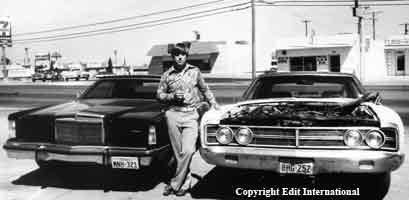 The modified car was extensively tested and engineers found no evidence of fraud. In one test for the media Ogle drove his Galaxie, which unmodified got about 13 miles per gallon, 200 miles on a measured 2 gallons of gasoline. The results were so astonishing that the car was inspected for hidden fuel tanks. None were found and those who drove with him confirmed that they had never stopped to refuel.
The modified car was extensively tested and engineers found no evidence of fraud. In one test for the media Ogle drove his Galaxie, which unmodified got about 13 miles per gallon, 200 miles on a measured 2 gallons of gasoline. The results were so astonishing that the car was inspected for hidden fuel tanks. None were found and those who drove with him confirmed that they had never stopped to refuel.
Doubters became believers. Scientists were convinced his invention, dubbed the ‘Oglemobile,’ would soon reach world markets and earn millions.
Tom Ogle was checked out by corporate engineers and the US government who were astounded to discover the invention actually worked.
At the time I had talked with the late Senator Gaylord Nelson (Dem. Wis.) a long time contact of mine and a pioneer for U.S. fuel economy standards, about what this could mean for all of us.
“The potential benefits are too great for it to be ignored.” said the Senator and had asked the US Department of Transportation to make a thorough investigation of Ogle’s system but was met with a wait and see response from officials.
Another big supporter of Ogle’s invention was Professor Gerald Hawkins of Texas A&M University, holder of a doctorate in mechanical engineering with a background in gas dynamics and aerospace study.
“This is no hoax,” said Dr. Hawkins, “Ogle eliminated the carburetor and achieved what the gasoline internal combustion engine was supposed to do all along – to operate off fumes.
For most of the world, the name Tom Ogle has never been heard or at least long forgotten. But, thirty years later can I still hear Tom’s voice from our recorded interviews promising the world better future.
It all started with a lawn mower
During our interview the eager young inventor revealed how he had discovered his fuel efficient system by accident; “I was messing around with a lawn-mower when I accidentally knocked a hole in its fuel tank. I put a vacuum line running from the tank straight into the carburetor inlet. I just let it run and it kept running and running but the fuel level stayed the same. I got excited. The lawn-mower was running without a carburetor and getting tremendous efficiency.”
The engine got so hot Ogle used a fan to cool it and was amazed when it ran 96 hours on the fuel remaining in the mower’s small tank.
He went from the lawn-mower to the automobile, converting a car in the same manner. Its engine started immediately, but the gas tank collapsed inwards. It took months of reinforcing gas tanks before he solved the vacuum problem.
But the car, without its carburetor and fuel pump, still had no acceleration. It couldn’t run faster than 20 mph. And the modified engine averaged only 8 miles to the gallon, and stalled after a few miles.
One time he crawled under the stalled car to examine its gas tank and found, “It was freezing cold, like an ice-cube. As I was sucking vapor out, it was acting like a refrigerator with liquid on the bottom and fumes on top.”
When he warmed the gas tank with heater coils, the miles per gallon sky-rocketed to over 100 and Tom Ogle never looked back.
He believed his system was the answer to the world’s pollution problems and demonstrated virtually zero pollutant emissions coming from his engine exhaust.
Soon Tom found himself courted by oil companies and financiers. Everyone predicted he would become a billionaire.
A few months before I had met him he was contacted by C.F. Ramsey an ‘international financier’ who wanted to buy Tom’s patent and the marketing rights to the Oglemobile.
Ramsey told me by phone, “We signed a preliminary agreement with Tom Ogle the very next day after we saw the invention. All kinds of people were in town, J.C. Penny, Transamerica, General Motors, Ford and others. Specifically Shell Oil offered Tom $25 million. Everybody was after him.”
But in every case the proposed backers wanted controlling interest in Tom’s patent. They wanted to stick Tom off in a laboratory. And that would have been the end of Tom Ogle and his fuel efficient system.
And it was. That is exactly what happened.
Ramsey signed a contract which let Ogle work on his device with financing from Ramsey who would take over the patent, distribution and development rights of the Oglemobile.
With thousands flowing in, the confident Tom Ogle I had met was quickly building the life of luxury and extravagance.
A few months after my first interview, his backer C.F. Ramsey sold out to Advance Fuel Systems Inc. in June of 1978. [a pre-planned hand-off] Tom was a bit nervous in my later phone calls, but all seemed to be well. He would continue receiving $5,000 a month and funds for research and development. He’d also get 6 percent royalties when the device came to market. Advance Fuel’s own engineers would develop the ‘Oglemobile’ for marketing and in April 1979, a still very ambitious Tom Ogle opened the first of a planned 1,000 nation-wide diagnostic car centers.
But Ogle’s first and only car center soon closed and his monthly checks stopped. Ogle was told he’d get no royalties because AFS was working on a device that got similar results but wasn’t his invention.
Shot and Poisoned
Continuing in his spiraling downfall from quick success and media attention in 1981, Monica, Tom’s wife left him and took along their five-year-old daughter Sherry. Then on April 14th he was shot in the street by someone who ‘got away’ yet he survived the incident.
On August 18th a broken and forgotten Tom Ogle, drunk, left The Smuggler’s Inn, the same place that I’d first met him. That night he went to a friend’s apartment and collapsed.
He was declared dead at El Paso’s Eastwood Hospital. His death, which involved a combination of Darvon, a prescribed pain killer, and alcohol, was ruled accidental or suicide. Many believed it was a cover-up for murder.
“Ogle had been gravitating toward gambling at the pool table, and began losing a lot of money in his gambling forays. He indicated to his attorney, Bobby Perel, that he believed people were drugging his drinks. Perel was skeptical, but on August 19, 1981, Ogle collapsed and died from what an autopsy showed was an overdose of Darvon and alcohol. The death was ruled to be a suicide after a cursory investigation, but several people close to Ogle indicated that they did not believe that Ogle would or could kill himself.”
From: www.automotiveforums.com/t130379-discuss200mpg_carburetor_conspiracy_.html

difficult to put out
Postscript
In 1989 another American inventor, Stanley Allen Meyer, claimed to have invented a means by which a car could be fueled solely by water. He alleged that he had created a dune buggy which could travel across the United States on twenty-two gallons of water. He died in 1998 while celebrating the success of his invention with his brother and two financial backers from Belgium. Although his cause of death was stated as having been a brain aneurysm, many have speculated that he was poisoned so that the news of his invention would not spread and decrease the need for foreign oil. At the time of his death, Stanley Meyer had twenty patents on many water-fueled inventions.
The End
By Ron Laytner
Copyright 2010
Edit International
“Ogle Fuel System”
By Gregory Jones
He insists there were no hidden fuel tanks or other alternate fuel sources used to power a two-ton automobile for 205 miles Saturday on only two gallons of gasoline fumes.
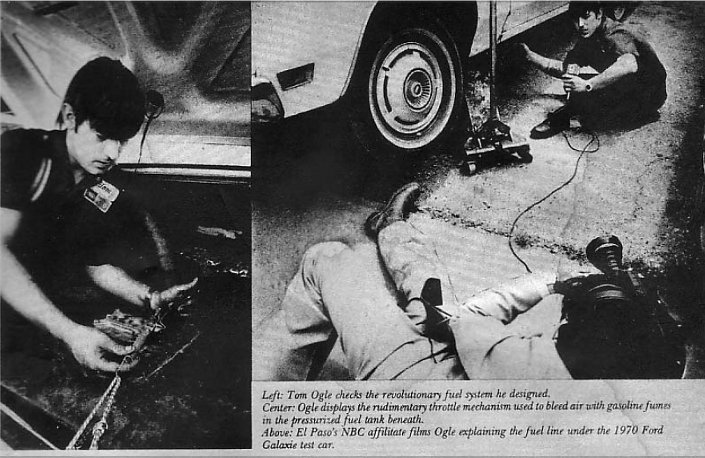
Ogle isn’t alone, others verify his work.
Carl Wright, for example, has been working on internal combustion machines for 35 years. He is a certified teacher of auto mechanics and is currently shop foreman at Peck’s Automotive Service, where Ogle built his controversial energy-saving fuel efficient system.
“It’s no hoax.” Wright said in straight-forward fashion. “There were no hidden tanks.” Wright, who has no vested interests in the invention, said at first he was skeptical of the young man’s invention.
“I’ve watched the thing from the time they built the fuel tank to the very present,” Wright said, “It looks to me like it’ll do what Tom said it would do.”
Wright said any secret fuel compartments would have required many extra man-hours by Ogle to install in the car body.
“He only worked on the car during office hours,” Wright said,”and he didn’t have a key to the door” to get into the automotive shop during off-hours or weekends.
Experts Probe Ogle Fuel efficiency System
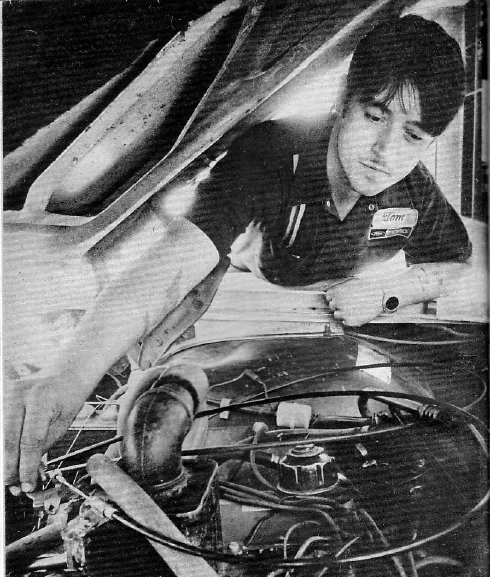
“He has not been here working on the car at nights, and the car has been locked up here every night.” Wright said.
James Peck, who owns Peck’s Automotive, has a 50-50 partnership on any royalties from the invention. And he said he would stake his 30 year professional reputation in northeast EI Paso on the fact that there was no hoax involved in Saturday’s test drive.
“I personally believe he (Ogle) had some help some-where along the way developing the system, although he will not admit to that. But I can vouch that the system works. It’s no hoax. It was my car he converted. We built system in my shop. I’ll put my name on the line. It definitely works.
Peck said he provided financial back for Ogle’s invention after he and Ogle met about a month ago and discussed the system.
Frank Haynes Jr. is registered state engineer with degrees from the University of Texas at Austin and Southern Methodist University. He was at Peck’s Automotive Saturday where he looked the system over and talked with Ogle.
“From what I saw, there was no hoax.” Haynes said, adding that he learned of Ogle’s invention in The Times.
” I decided to venture out and see what was going on,” he said. ” I’d never even heard of Tom Ogle before. But I’m familiar with combustion from previous work and wondered what the kid had come up with.
“What I saw was very convincing,” Haynes said. Haynes said he felt the only chance of a hoax might have been in the amount of fuel that actually was in the tank.
Prior to the test drive Saturday, reporters and onlookers witnessed a mechanic at Peck’s empty the special, pressurized gas tanks, and pour two gallons of fuel into the tank after it was empty.
Haynes said he was additionally convinced of the system’s authenticity by the fact it was difficult to start the car before heading to Deming.
“The car had to be primed quite thoroughly in order to run. That gave me the idea that there weren’t any fumes in the system after drainage.
“That was quite convincing for me personally. If there had been hidden fuel, there wouldn’t have been any difficulty in starting the car, according to how he (Ogle) described the system to me,” Haynes said.
Haynes described Ogle as an “open, earnest young man who convinced me everything he said should be true.”
Ogle all along has maintained nothing but simple trust in his invention.
“It works,” he said frankly. “There is no hoax.”
He described his Saturday test drive, in which a times reporter participated as a “beautiful performance.”
Ogle added with a chuckle that the return to El Paso from Deming was made with one pint and two ounces of fuel left in the fuel tank.
“We did pretty good though. We made 205 miles on less than two gallons,” he added.
He said he maintained constant 55 to 60 mile per hour speeds.
1979 U.S. Patent number #4,177,779 “Fuel Economy System for an Internal Combustion Engine”
“200 Miles On Two Gallons Of Gas”
El Paso Times (Texas) Sunday, May 1, 1977
By John Doussard
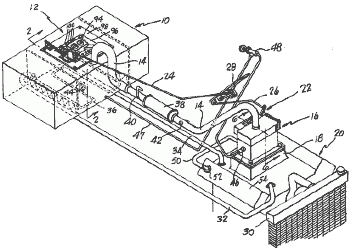
“Once I get to Deming and back I’ll have everybody banging at my door!” Tom Ogle exclaimed. It was as uncommon sentiment that may very well prove to be true.
Saturday the 34-year-old inventor mechanic climbed behind the wheel of his 1979 1970 Ford Galaxy and headed down the road toward both the dusty New Mexico town and possible fame, fortune and a solution to the energy crisis.
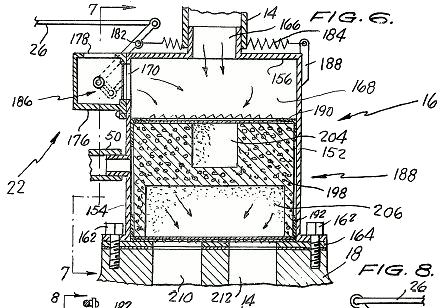
With only two gallons of gasoline in the tank, Ogle offered strong evidence that the tangle of red hoses and tubes racing between the back of the 5,000 pound car and the engine performed as billed: delivering over 100 miles to the gallon while averaging close to 60 miles per hour.
Indeed, in a day of automotive and personal triumph, the only sour note was sounded when Ogle failed to bring his gas-saver back into El Paso as planned. On the outskirts of town, just a few miles from his final goal, a rock struck the underside of the car,puncturing a filter and allowing the gas fumes the auto travels to escape.
But it really hardly mattered at that point. Ogle had traveled 205 miles on slightly less than two gallons of gas.Some of the precious liquid had been spilled when first poured in the tank.
“I use about four gallons of gas every two weeks,” Ogle said. “But then I drive an awful lot.”
Actually, Saturday’s performance was rather modest. Ogle claims his system will average about 160 miles per gallon in city driving, treatment average of 12 miles per gallon.
“I fixed-up my car, a 1972 Thunderbird with a 429 cubic inch engine, with the system,” Ogle said. “I then took it to Cloudcroft and back on two gallons, about 200 miles.
“And I still had enough to drive around when I got back in town.”
The odd thing about Ogle’s system is that doesn’t add complex gadgets and intricate gimmicks. Instead, it removes the carburetor, a piece of the engine long considered sacred.
“Engineers said it wouldn’t work because without a carburetor there’s nothing to vaporize the fuel,” Ogle explained during the trip across the hot dessert. “They couldn’t understand that it’s already working on vapors.
“Instead everybody kept trying to add something to the carburetor while nobody thought of taking the thing off.”
Basically the system uses a standard engine with a few modifications In lieu of the carburetor there is a series of hoses feeding a mixture of gas vapors and air directly into the engine.
Gas in the tank passes through a series of filters, which stretch the energy available in each gallon. The ??? also store excess vapors for later use for up to 45 days. Premium gas is needed, as its higher octane level allows for more vapors to build.
Not only does Ogle’s car promise more miles per gallon, but he says it will clean the environment while causing its owner fewer repair headaches.
“It will top anything on the road today, being smoother, better running and more efficient,” Ogle said. “The life of your car will be two times longer because there will be no carbon build-up.
“The carbon comes from unburned gas, but we burn it all.You won’t have need all the catalytic converters for the air.”
Before the journey began, two Times reporters looked the car over for possible hidden sources of fuel, and found none. Then a brief ceremony emptying the gas tank, and after the last drop fell, two gallons were poured back in.
While only an expert could say for sure the trip was completed with only those two gallons, spectators, reporters and other interested inventors present all appeared satisfied.
“This is the hottest thing of this century,” Frank Haynes, Jr. an independent engineer living in this area, said. “Engineers have been beating their heads against the wall to come up with something like this.
“I honestly don’t think it’s a hoax.”
Mileage Astounds Experts
The Tribune (June 8, 1978) By Ron Laytner
El Paso, Texas — Is a young high school dropout the most important American inventor since Thomas Edison?
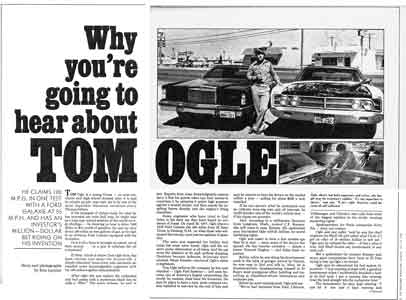
The Philadelphia Inquirer believed Ogle was perhaps the greatest inventor since Thomas Edison and predicted the world would be hearing a lot about him. – Photo by Ron Laytner, Edit International
Will he and the world energy shortage and show us how to drive from New York to Los Angeles on $15 worth of gasoline? Or is it all a hoax to get inventors’ money and infuriate the oil companies?
El Paso has been excited ever since 25-year-old Tom Ogle, a simply-educated, home-town auto mechanic, astounded engineers by converting his car’s engine so it appears to drive 100 miles on a gallon of gasoline.
Ogle did away with the carburetor and fuel pump, replacing them with a secret black box he calls a filter. The super mileage, he said, was due to his pressurized, vaporized fuel system that injects fumes directly into the engine’s firing chambers.
Engineers have tried but found no evidence of fraud. On April 30 last year (1977) Ogle drove a 1970 Ford Galaxy 200 miles from El Paso to Deming, NM, on a measured two gallons of gasoline. The auto was inspected for hidden fuel tanks but none were found.
Ogle and his car were under observation at all times yet the “Oglemobile” went the distance without stopping for fuel and averaged 100 miles per gallon at 55 mph. Doubters became believers. Scientists were amazed. Many were convinced Ogle’s claim is legitimate.
Tom Ogle believes his new company, Ogle Fuel Systems, will soon become one of America’s largest corporations because the world must have his invention. He plans to have a miniaturized version installed in test cars by the end of July, and expects to have it on the market within a year, selling for about $300 a unit, installed.
If he can survive criticism by giant auto and oil interests he could become one of the worlds richest men. And he will, according to millionaire C.F. Ramsey, an international financier from Longview, WA, who has backed Ogle with “unlimited funds” for world-wide marketing rights.
Ogle was easier to meet with a few months ago but with success he’s become reclusive, a junior Howard Hughes hiding from the press.
Then, he was set up in the back of garages owned by friends. Now, he is incommunicado, headquartered in El Paso’s most prestigious building and travelling in chauffeur-driven limousines and corporate jets.
Before he went underground, Ogle told me, “We’ve had inquiries from Ford, Chevron, Shell, Volkswagen and Chrysler and calls from the biggest retailers in the world wanting marketing rights.” But company spokesman denied contact.
Ogle said he refused one man,”Said he was the chief engineer for Shell oil and asked what I’d do if I got an offer of $25 million to sell out.” Shell denies it.
But a spokesman for investor Ramsey, said many giant corporations had been in El Paso trying to buy up control of Ogle’s invention.
The inventor said he discovered his fuel efficient system by accident, “I was messing around with a gasoline lawn mower when I accidentally knocked a hole in its fuel tank. I put a vacuum line running from the tank straight into the carburetor inlet. “The lawn mower kept running.
“I just let it run and it kept running but the fuel stayed the same. I got excited. The lawn mower engine was running without a carburetor and getting tremendous efficiency.”The engine got hot so Ogle used an electric fan to cool it and was amazed when it ran 96 hours on the fuel remaining in the mower’s small tank.
He went from the lawn mower to the automobile engine, converting a car in the same manner, its engine started immediately but the gas tank collapsed inward. Many months and reinforced gas tanks later, he solved the vacuum problem.
But, the car without its carburetor and fuel pump, had no acceleration. It couldn’t run faster than 20 mph. And the modified engine averaged only eight miles to the gallon and stalled after 10 miles.
One day Ogle crawled under the stalled car to examine its gas tank and got a surprise;”It was freezing cold, like an ice-cube.As I was sucking vapors out, it was acting like a refrigerator with liquid on the bottom and fumes on top.”
When he solved the stalling problem by warming the gas tank with heater coils, the miles pre gallon skyrocketed to over 100. Tom Ogle hasn’t looked back since.
He believes his system is the answer to the world’s pollution problems and has demonstrated virtually zero pollutant emissions coming from his engine exhaust at computerized auto engine test centers.
In a typical test, with the engine running and the speedometer over 55 mph, a jet of clean hot air, without the usual obnoxious smell, leaves the Oglemobile’s exhaust pipe.”You can dry your hair with it,” said Tom Ogle.
After an hours high-speed run, water in the radiator is only luke warm. And a spark plug installed before the test comes out cleaner than it had gone in.
He isn’t afraid of oil interests.”My wife Monika is scared, afraid I’ll get kidnapped. But I’m safe. People still can’t believe or understand what I’ve discovered.
Ogle said he asked President Carter’s assistance with developing his invention and had sent the president all the data and test results on his experimental model. At one point an official with the U.S. Energy Research and development Administration declared Ogle’s vaporized fuel system contained no fakery.
“I think personally, and with strong conviction, that there is no hoax,” said Richard W. Hern, fuel engineer systems supervisor at ERDA’s research centers at Bartlesville, Okla. on May 6, 1977, after examining Ogle’s invention until his patent and other legal matters were settled.
But later Hern said it was impossible to get such mileage as the invention promised. He couldn’t say more, he declared, because he was bound by a statement of confidentiality he signed so that he could view the invention.
Ogle’s noisiest critic has been Robert Levy, an El Paso physicist who insisted it was impossible to move a 5,000 pound car more than 50 miles with the energy contained in one gallon of gasoline. Levy had stated the Oglemobile was a fraud but lately, as Ogle’s credibility grows, he has backed off, denying he ever called the system a hoax.
Mack Massey, an El Paso auto dealer, who claims he’s an early Ogle backer, said a patent search made last year on Ogle’s system turned up a similar General Motors patent approved in 1972. But GM spokesmen said the company had more than 500 patents granted that year and would need a patent number to find out which invention Massey spoke of.Ogle said he received a phone call from GM requesting permission to inspect the car. But Joe Karshner, a company spokesmen, said “We haven’t approached Ogle. He has never made a submission to us and we’ve never gone to him.
“This is very controversial. We are interested in anything and everything that would improve a vehicle’s performance. If Ogle’s invention is legitimate we would be interested. He is free to come to us.”
Highly qualified men praise Ogle’s system: John Whitacre, professor of mechanical engineering at the University of Texas, El Paso, said, “To me it looks like the only thing leaving the tank is air vapors, giving better combustion. It’s a different approach working with gas already vaporized.”
Another supporter is professor Gerald Hawkins of Texas A&M University, holder of a doctorate in mechanical engineering with a background in gas dynamics and aerospace study, member of the American Institute Of Aeronautics and Astronautics and The American Society of Mechanical Engineers.
There is no hoax eliminated the carburetor and achieved what the gasoline internal combustion engine was supposed to do all along-to operate off fumes. I don’t know why somebody didn’t try this before.”
Another Texas inventor, Frank Read of Fort Worth, said he perfected a system to improve gas mileage and that fights with auto manufacturers almost broke him. He said he underwent 11 court battles with oil companies trying to buy of his unit with an agreement he never build another. He felt Ogle had a long, hard road ahead.
In Washington a spokesmen for U.S. Sen. Gaylord Nelson (D.Wis.) said, “It sounds to good to be true.But if the Ogle invention proves feasible, results would be awesome.
“America could become oil self-sufficient and the drain of oil dollars to the Middle East ended.” said Jeffrey Neddleman, legislative assistant to the lawmakers who pioneered U.S. government fuel economy standards.
“The potential benefits are too great for it to be ignored. The senator is asking the Department of Transportation to make a thorough investigation of the Ogle system.”
Argosy magazine
The August 1977 issue of Argosy magazine which carried a five-page article on the Ogle mobile has disappeared from many libraries and even the Library of Congress. Argosy even ceased publication shortly after the article published. The El Paso NBC TV station which had filmed the test run “lost” the footage.
http://www.criticalunity.org/news/energy/283-history-of-new-energy-invention-suppression-cases
next: Ogle in Argosy magazine
Today
For detailed instructions on how to get 200-to-400 mpg fuel efficiency (run your car on fumes) see our page
Run your car on vapors

the T fitting: 1-1/2 inch diam. = $3
1-1/2 inch diam. vinyl tubing = $3/ft
from your hardware store
Run Your Car On Vapors
Car gets 400+ MPG John Weston
Super Carburetors
Charles Pogue Carb.
Ogle in Argosy mag.
A Hydrogen Generator You Can Build







You have to remember a gallon of gasoline only has so much energy. One hundred miles per gallon could be feasible for a small vehicle, but not so much for for anything over three thousand pounds in weight. Car companies don’t care about oil companies, they care about making efficient engines and if a one hundred miles per gallon system was doable they would make it. I would love a car to realize one hundred miles per gallon but that’s not going to happen in my life time.
read this page and learn -editor
“car companies? don`t care about oil companies? That is totally incorrect, my good man.” Toyota does NOT care about fuel efficient engines, if they did they would run Ogle`s anti-carb system.
It`s all about making you stop and gas up (supply has to = demand.)
So yes, car companies (automobile manufacturers) are completely in bed with oil companies and have cars tuned to what they say the mileage will be.
The Tesla AC induction “motor” in best for road travel as internal combustion engines are best for off road power etc.
Has anyone got any good photos of the setup I think this can be done in 2019 for sure
Robert S,
How can we; the commoner, obtain the basics of the design…?!?
Thank you.
Check out the Patents Office. There’s a PDF there with at least one diagram and all the basics.
the drawing and more is here; and yes,you can look it up and see it.
where can we get the design?
It coverd up but the government. There are simmalar designs out there. But everyone i talked to can not achive 100+ miles. ive been collecting data and hope to get something Workin in my 70s truck.
The engineering universities are in on the stifling of technology, e.g.: fluid dynamics professors who do not know about hydraulic rams or how they work! It was next to impossible to test/demonstrate a fuel vaporizer for an engineering design class! It is long past the time when the citizens of the world must become involved in deciding/mandating the technology that will be developed for the good of the people, not the corporations! An overhaul of the mission of the government and academia is needed to work for the national security of its citizens, not corporations.
Ever wondered why at the beginning of the 20th century Ford and other unscrupulous oil companies where buying up all the city electric rail lines? They didnt want competition. Today 2017 the big three I am sure where behind getting VW out of the consumer diesel car industry. Why because you got over 40-50 mpg out of a VW TDI and they hate it! VW actually designed a diesel that got close to 70mpg as well. US wont allow it! Our corporate fascist government doesnt care about saving the world thats a farce!
It was General Motors that bought up most of the rail lines.
I remember this on the news back in the late 70’s.. but like one of the commenters said, you would get throw in jail modifying the emissions components of an engine. I live in BC, Canada now as I did back then, and it became a “federal offense” to modify fuel components as well.. a relative worked in a “Government air-care testing facility” in Burnaby and confirmed this with me.
Some of these stories back then inspired many to take on the system and “oil crisis” of the time, many fakes popped out of the woodwork. I believed Tom was on to something, but wound up getting distracted by what it was worth and all the inquires and attention of others.
I made a call into Ford motor company and Shell oil back in 1980 with a similar idea, the oil company snickered and took my name and phone number, but the Ford motor company lent a “development engineer” to come out from Oakville, Ont. We chatted several times on the phone before his visit. He told me that there have been “several” claims to this process, some patented, others with a patent pending. I told him that I did not have the means for any sort of patent as I was quite young at the time.
During his visit, he wanted to see the car, which was a Ford 1969 Montego with a 289cid engine and a C4 transmission. The R/H exhaust manifold was removed and a fuel heating atomizer was added. This device went through several modifications and eventually was able to power the car and produce usable horsepower without issue. The first revisions used an Impco “dual fuel” carb modification (which was popular at the time for propane conversions) but we ran into trouble with fuel condensing inside the secondary regulator at high rpm. This would spill into the intake manifold and cause manageability issues. With the dual fuel carb top regulator, the engine could be started on the gasoline supply and after the engine warmed up, switched back over to vapor. This process was eventually “automated” with various re purposed egr/emissions vacuum switches. An A/C compressor was added to the engine and used to pressurize the vapor system and store a fair amount of “gas” in an old 20lb propane tank in the trunk. This eventually led to the old Impco dual fuel carb/regulator being replaced with a new propane mixer and secondary regulator. This configuration was what needed to happen, but the plumbing was getting quite complex and hard to keep condensing fuel out of the larger vapor lines. It all worked, but I needed some help!
During the visit with the engineer from Ford, he looked everything over and told me that he wanted a demonstration. After a bit of messing around, myself and a friend got the car running and went out for a drive with him. There were no plates on the car, so I was a bit paranoid, but went anyway. The engineer had asked that we disconnect the fuel line from the rear tank at the mechanical fuel pump inlet next to the timing chain cover. We ran a length of 5/16 fuel line through the firewall and into an old quart oil can that I had taken a can opener to and opened up the top half way and inserted the hose. I never thought about it spilling while driving (or the hazards thereof), but my friend held the can during the drive. We left my home which was on Schoolhouse rd and Comolake ave and headed south for the highway #1. The quart can of gasoline was near 3/4 full at this point, but during the first few miles, the level went down quickly and then slowed once we got out on the highway (which I did not understand until later). We drove all the way to a place called the Otter CoOp store out near 164th in Langley and the can was almost empty, this was a fair distance as my pickup truck with a 302cid (virtually the same engine) used more than a few gallons of gas for the same trip!
The Ford engineer took us out for lunch and discussed what he thought about the process and some questions about the vaporizer’s internals. I told him everything he asked, afterwards, we got back in the car and drove back to Coquitlam with a gallon jar we were given at the restaurant filled half way with “premium”. We used even less fuel for the trip back, It was simply amazing!
We parted ways with the Ford engineer later that day and he said he would call the following monday after he spoke with his “superiors”. That weekend, my friend and I decided to dismantle the components from the engine and see if we could optimize the process somewhat. The car was parked at his home in a closed garage next to his house. After a few weeks and no call from the Ford engineer, I went over to my friends house and gave him the news. He was a bit surprised and taken back by my visit, he told me that a “red tow truck” came two weeks prior and picked up the car. I was freaked out to say the least! So I asked for the details and he said a man came with papers and a tow truck to remove the car, they told him that the car was sold to them and they came to pick it up. He obliged and that was the last we ever saw or heard about that car. I called the police and told them, but because the papers were in the car and I had not ever insured it, I had no record of the VIN or previous owner. At first, I had thought my friend got greedy and sold it to someone, but he was too solid for that. I even checked with the garage I worked for next to Car-City on King George in surrey, but nothing! It was gone without a trace!
The players were;
Roy Ashby (ex employer and owner of “Roy’s Automotive” on King George Hwy, he was a retired RCMP officer)
John Wilkes (My friend whom I’ve never seen again after the car was taken, he was always in trouble with the law at the time and a “native-indian canadian”)
? Thompson (The engineer from Ford in Ontario)
The car was a 1969 Ford Montego 2DR HT, metalic blue with a 289CID V8 and a C4 automatic transmission.
Robert
Tom was our answer to our oil and gas problems but the oil and gas company wouldn’t make any money so day ended up getting rid of him and they would still make there millions and billions of dollars with him gone.and with his plains for the new fancy carb that got 100 miles per gal.disaperd when Tom was killed the gas and oil companies has never let anyone leak out about it not even over 35 years later.
This is part of my response to Tom Olge’s death. I will tell u guys what I would tell the killers, and talk from a third-person speaker: Screw the people who did this to Tom Ogle, in not saying names, but, all the oil comanies, gas companies and maybe the government was in on this, so SCREW U GUYS FOR SOING THIS TO TOM OGLE!!! Really!? What in the world were u guys thinking?!! U screwed a guy who found a way to make this world filled with “less carbon dioxide close” and to make this planet a better planet, and stop global warming him?! Why would you kill a guy that was trying to help our planet? (Yes) If you wanted to make this planet better, you could also do something like him, and make a part for car more efficient and get way more money off of that then you could at your crap filled gas stations. Really people, u make me sick!!! (And for those who say he died of natural causes, ur wrong! Dead wrong! He was killed by jealous and greedy wanta-be gas pumpers, and idiots who thought wrecking the planet, and making money off of it was okay.) This is all I’ll say for now or else I’ll tear my room apart over it, but here is part of my response to Tom Olge’s death. Thank you for reading me response!
Screw the people who did this to Tom Ogle, in not saying names, but, all the oil comanies, gas companies and maybe the government was in on this, so SCREW U GUYS FOR SOING THIS TO TOM OGLE!!!
The article states ‘Ogle may have had help.’ Well actually he did have help. There were about 6 people involved with the invention. All of which died mysteriously during that time. In one instance, when one of the participants had just been pronounced dead, the family returned to his home to find it had been flooded with mercury. Thus making any investigation impossible. I heard this story about 15 years ago and thought it was just BS at the time.
very sad – inhuman.
As a retired engineer, I still ask the question “What if?” I guess in much the same way that Tom Ogle did.
What if a bullet proof 1/2 gallon tank was welded in the engine compartment with non-return valves to allow air in to agitate the mix and so that heater tubes from the motor can be wrapped round to keep the gas warm? What if a small amount of software were developed to ‘sniff the vapor” entering the motor to keep it in the window of optimine burn value, connected to the throttle?
My kit is run on a 2 litre Ford; the advantages being twice the milage – conservatively – almost twice the life of spark plugs and lub. oil and an apology from the MOT station that their emission test equipment seems to be at fault by hardly registering anything.
Thank you Tom Ogle. Top man!
If an entire magazine went out of business after discontinuing articles on Tom Ogle, media pieces disappeared from the Library of Congress and the man died in his mid-20’s it’s clear the government was involved in his death. Notice passenger car mileage hasn’t improved beyond 20-30 mpg in 50 years except for hybrids and/or electrics. Sad that people can let this kind of thing happen and set engineering and ecology back 100 years all for the sake of money.
For those in Government who say they believe in God, then it’s fair to say they have with their hypocrisy brought us disaster. By that I mean we have had the technology for a long time to have reasonably priced fuel long before Oil was discovered in the Middle East and we would not as a result be involved in their wars. Who knows if their Brains were not in their asses we would have some wonderful new industries and stable economies with plenty of jobs. God help us as it appears the blind are leading the blind. When I think of Pogue, Wagner, and Ogle, what we could have done by embracing their genius instead of burying them. Sad.
In Iowa, 2006, on diesel engines, we achieved 20% reduction in fuel consumption, 40+ % reduction in particulate emissions and 15% Horsepower increase–much better for gas engines. A Canadian reduced auto fuel use to 200 mpg in cars and 70 mpg in military tanks. I know the technology but the oil companies would rather have you buy more oil.